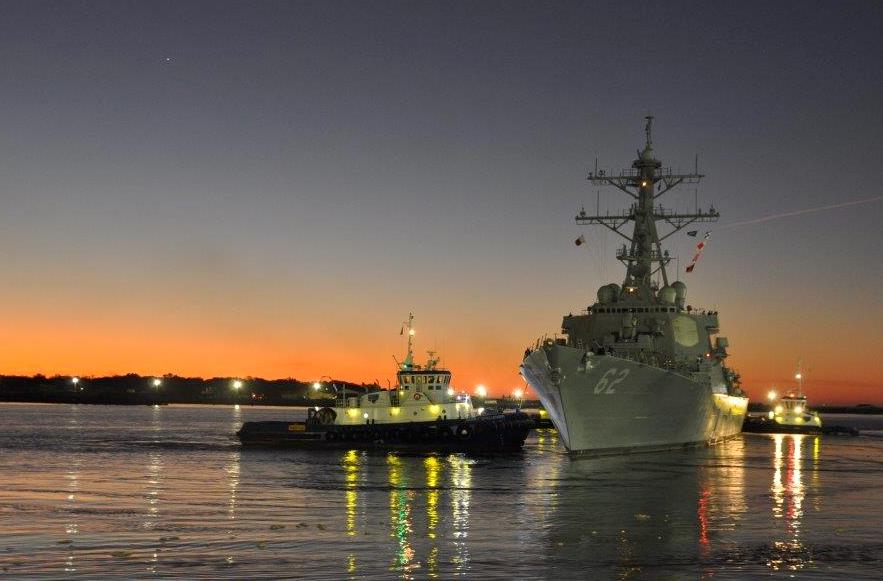
This post has been updated to clarify where USS Fitzgerald (DDG-62) was built. The destroyer was constructed at Bath Iron Works, Maine.
After more than two years of repairs, guided-missile destroyer USS Fitzgerald (DDG-62) left the Mississippi coast for sea trials in the Gulf of Mexico, Navy officials announced on Monday.
The Arleigh Burke-class destroyer departed the pier at Ingalls Shipbuilding in Pascagoula, Miss., at about 7:30 a.m. on Monday. It’s the first time Fitzgerald has been underway on its own power since the ship limped back into port after a 2017 collision off the coast of Japan that killed seven sailors.
The trials will test the ship’s systems after the extensive repair work that has been taking place since the stricken ship arrived in early 2018.
“Among the systems that will be tested are navigation, damage control, mechanical and electrical systems, combat systems, communications, and propulsion,” reads a statement from Naval Sea Systems Command.
The warship left the dry dock at the Ingalls shipyard in April and has been completing its repairs at a pier. A spokesperson for parent company Huntington Ingalls Industries declined to comment.
“We are excited to take the next step to get Fitzgerald back out to sea where the ship belongs. My crew is looking forward to moving onboard the ship and continuing our training to ensure we are ready to return to the fleet,” Commanding Officer Cmdr. Scott Wilbur said in a statement.
The service budgeted approximately $523 million towards the repair and modernization for Fitzgerald, NAVSEA told USNI News.
During the collision on June 17, 2017, Fitzgerald collided with merchant vessel ACX Crystal. The flared box of the much larger Crystal crushed the superstructure of Fitzgerald, causing extensive damage to the destroyer’s radar and electrical system.
At the same time, the bulbous bow of Crystal punch through the ship’s hull and caused flooding that resulted in the deaths of seven sailors who were trapped in a berthing area. The flooding also caused extensive damage to the electrical system.
The damage required an unforeseen level of repair work for the destroyer, and the Navy elected for the ship to return to one of the two shipyards were Burkes are built. Fitzgerald was originally built at General Dyamics Bath Iron Works, Maine.
The Navy barged the ship from Japan to Mississippi.
“These repairs range from partial to complete refurbishment of impacted spaces to replacement of equipment such as the radar and electronic warfare suite,” reads the NAVSEA statement.
“Due to the extent and complexity of the restoration, both repair and new construction procedures are being used to accomplish the restoration and modernization efforts.”
USS John S. McCain (DDG-62), which suffered a similar collision that killed 10 sailors on Aug. 20, 2017, underwent repairs in Japan and underwent sea trials late last year.
The following is the Feb. 3, 2020 statement from NAVSEA.
PASCAGOULA, Miss. – The guided-missile destroyer USS Fitzgerald (DDG 62) is
underway to conduct comprehensive at-sea testing, marking a significant step
in her return to warfighting readiness.
The ship departed Huntington Ingalls Industries – Ingalls Shipbuilding’s
Pascagoula shipyard at approximately 6:30 a.m. (CDT) to conduct a series of
demonstrations to evaluate that the ship’s onboard systems meet or exceed
Navy performance specifications. Among the systems that will be tested are
navigation, damage control, mechanical and electrical systems, combat
systems, communications, and propulsion.
The underway reflects nearly two years’ worth of effort in restoring and
modernizing one of the Navy’s most capable warships after it was damaged
during a collision in 2017 that claimed the lives of seven Sailors.
“Since we launched the ship this past April our efforts have focused on
restoring ship systems, conducting pier side tests and readying the ship for
sea,” said Rear Adm. Tom Anderson, NAVSEA director Surface Ship Maintenance
and Modernization and commander, Navy Regional Maintenance Center. “The
government and industry team has been working hand-in-hand on this
exceptionally complex effort, with a common purpose of returning Fitzgerald
to sea and ultimately back to the Fleet.”
Upon Fitzgerald’s return to the shipyard, crew training and certifications
will commence as final work items are completed in support of the ship’s
sail away later this spring.
“We are excited to take the next step to get Fitzgerald back out to sea
where the ship belongs. My crew is looking forward to moving onboard the
ship and continuing our training to ensure we are ready to return to the
fleet,” said Cmdr. Scott Wilbur, Fitzgerald’s commanding officer.
After receiving its full complement of basic and advanced phased training,
as well as crew and ship certifications, the USS Fitzgerald will return to
the Fleet mission-ready with the improved capability and lethality required
to successfully support high-end operations.
Naval Sea Systems Command is the largest of the Navy’s five systems
commands. NAVSEA engineers, builds, buys and maintains the Navy’s ships,
submarines and combat systems to meet the fleet’s current and future
operational requirements.





